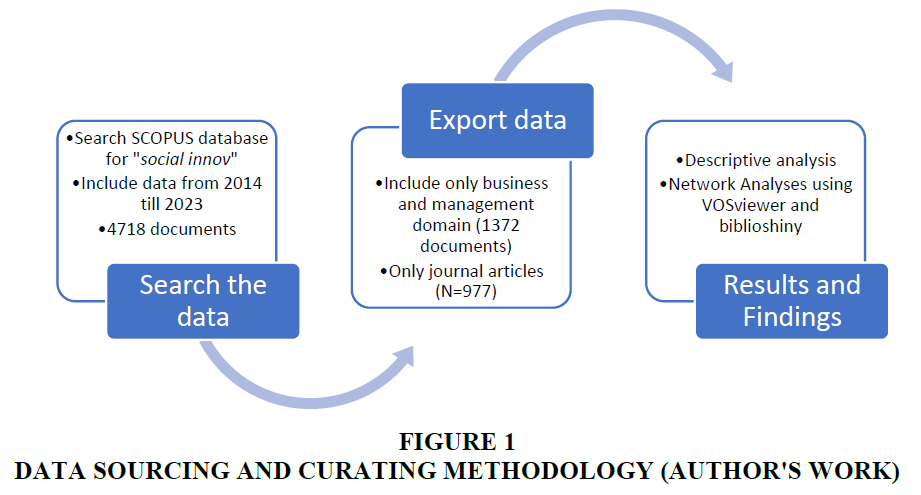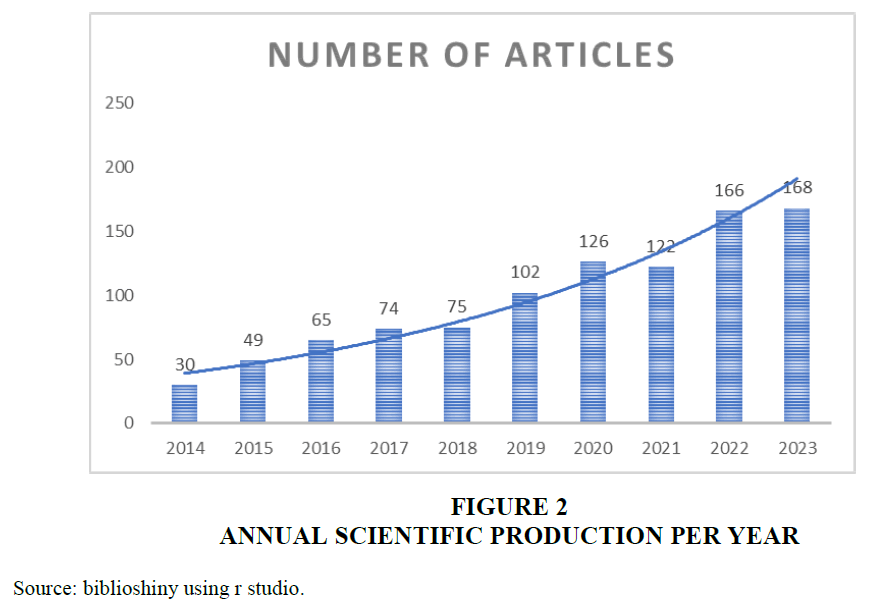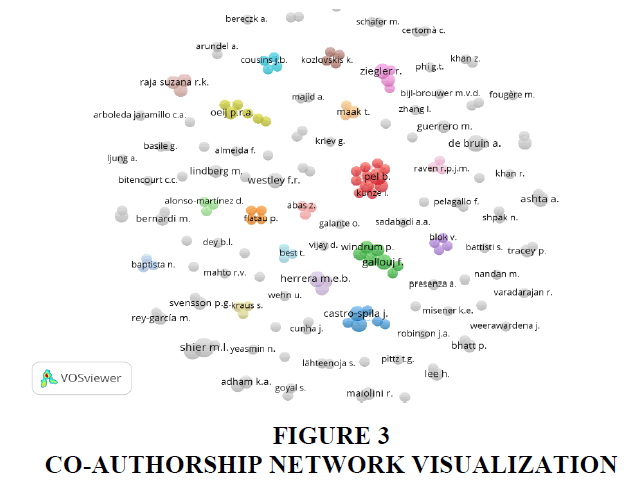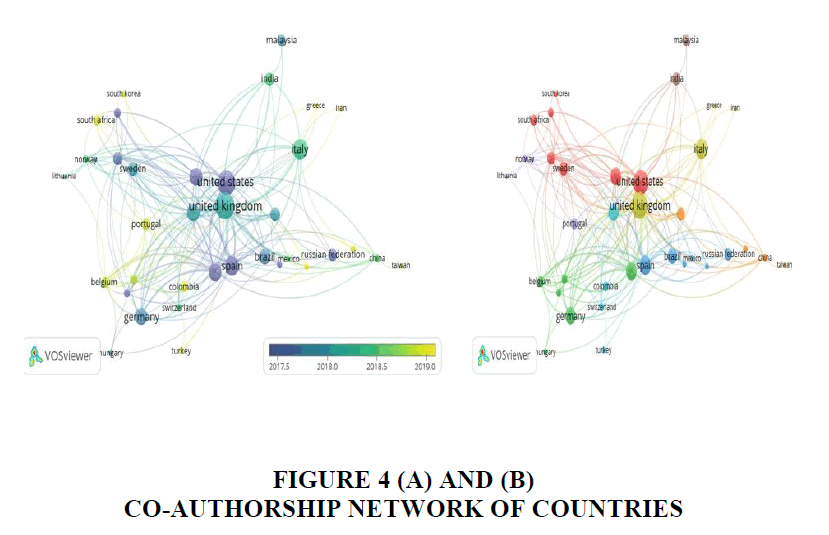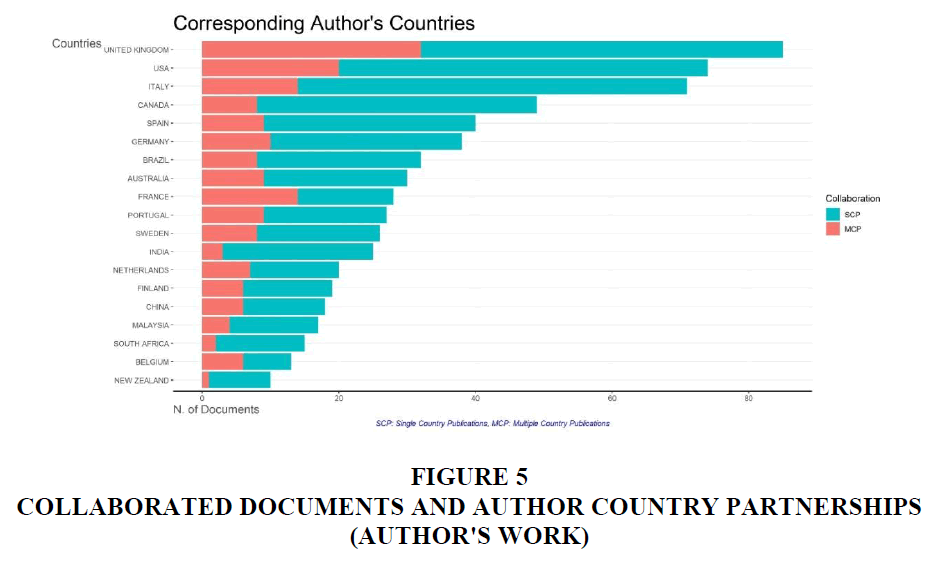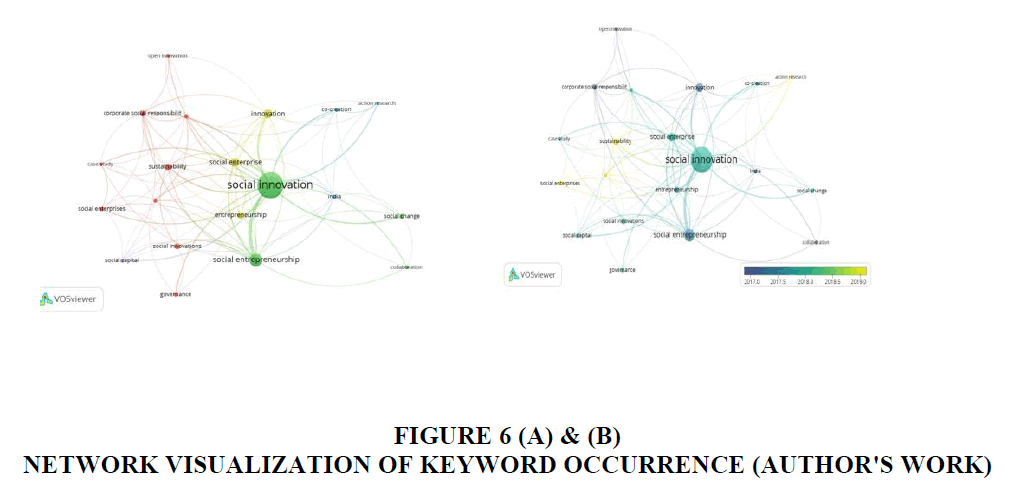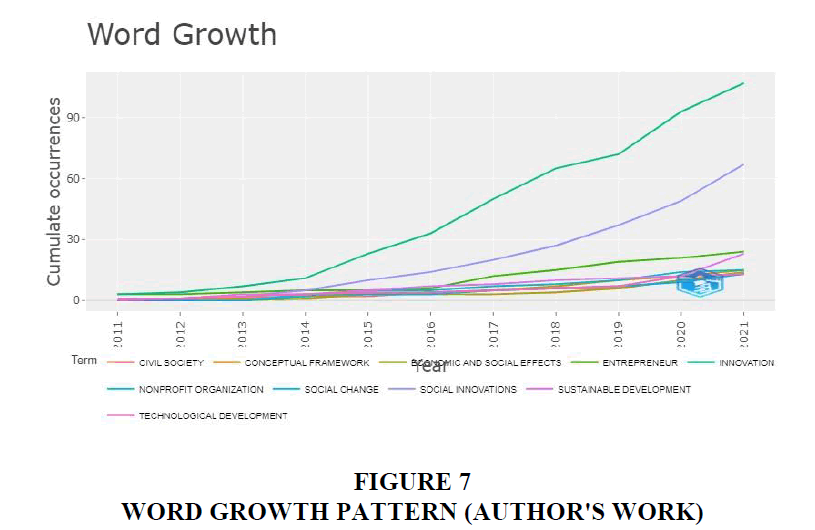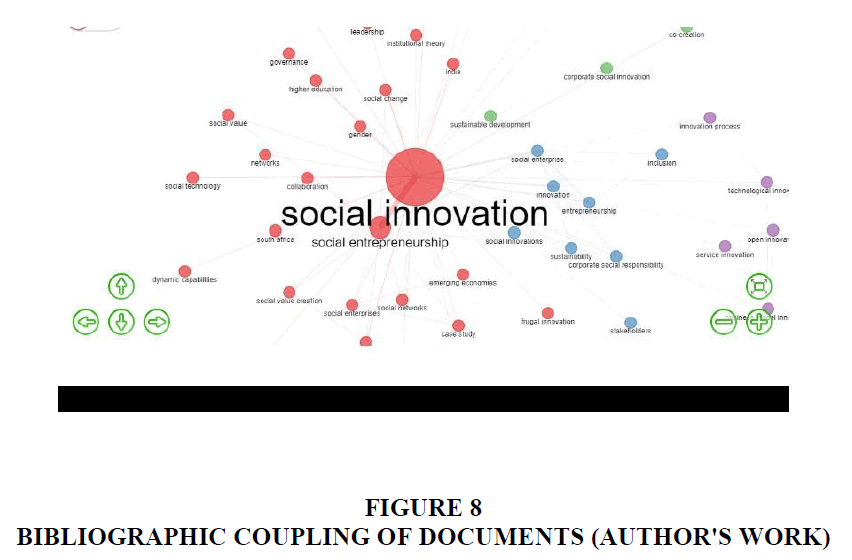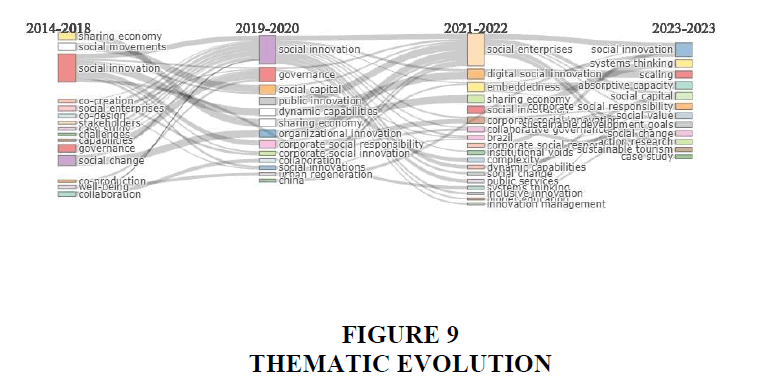Research Article: 2024 Vol: 28 Issue: 4
Recent Trends in Social Innovation Research Published in Business and Management Domain: A Bibliometric Analysis from 2014 to 2023
Mohita Maggon, MDI Gurgaon
Citation Information: Maggon, M. (2024). Recent trends in social innovation research published in business and management domain: a bibliometric analysis from 2014 to 2023. Academy of Marketing Studies Journal, 28(4), 1-15.
Abstract
The interest in social innovation research has increased exponentially in recent years. Despite the paramount importance of the phenomenon, there is plausible research dedicated to understanding the research trends and intellectual structure among “social innovation” actors (authors, institutes, countries, and journals). The paper presents a bibliometric analysis of social innovation research in the business and management domain. The analysis is conducted on 977 documents obtained from the Scopus database. The study period is selected from 2014 to 2023. The paper presents descriptive and network analysis through co-citation, bibliographic coupling, and keyword co-occurrence (2014-2023). VOS viewer and R studio’s Bilioshiny package are used for performing network analysis. The paper sheds light on the intellectual structure and evolution of social innovation research and also proposes directions for future research.
Keywords
Social Innovation, Bibilometric analysis, Network analysis.
Introduction
The origin of social innovation is as old as humankind. Any civilization survives with innovations and creativity exhibited by innovators. The history of innovation goes long back, but the understanding of social innovation is underdeveloped (Cajaiba-Santana, 2014). Social innovation originates from providing an innovative solution to a social problem. Social innovations have a prime goal of addressing a problem of social nature (Avelino et al., 2020; Fahrudi, 2020; van Niekerk et al., 2021). According to (Carayannis et al., 2021; Domanski et al., 2020; Repo & Matschoss, 2020), companies need to tap the potential of social innovation through all the functional areas of an organization. Technology is one of the forces that can assist innovation, but social innovation is a broad domain (Oeij et al., 2019). Occasionally, the terms social innovation (SI) and social entrepreneurship (SE) are treated as synonyms. But it is relevant to differentiate the two, so that the scope of current study is clearly established. (Maclean et al., 2013) suggested that there are some common aspects between SE and SI. First, both the concepts address the social problems. Secondly, social value is the core of both concepts. Third common characteristic is that both the concepts have emerged due to non fulfilment of social problems by states. Both SE and SI are related to each other because a social entrepreneur can solve a social problem through social innovation (Westley & Antadze, 2010).
Though being related and having common themes among each, there are fundamental differences midst SE and SI. “While social entrepreneurship research tends to focus on the individual driving social change, social innovation literature has concentrated on the processes and outcomes that lead to system-changing. The crux of this socially innovative behavior is that skills and expertise used to develop successful commercial innovations can be used to solve a wide range of societal problems” (Chalmers, 2013) (p. 19). (Phills et al., 2008) conducted a systematic literature review of SE and SI and treated both concepts as unidentical. Therefore, in sync with these studies, the present study also views SE and SI as different concepts and the scope is limited to exploring SI through bibliometric analysis. Many studies have investigated SE using bibliometric analysis (Celebi et al., 2020; Dionisio, 2019; Forliano et al., 2021; Iskandar et al., 2021) apart from (Hota et al., 2020; Rey-Martí et al., 2016).
However, despite the popularity of SI among researchers, the conceptualization and the research structure remain split and disseminated in this field. The growing interest of researchers in social innovation construct can be seen from more than 168 articles being published in 2023. There is a need for a comprehensive bibliometric analysis of the concept to match the rising attention in the area (Sadabadi, Ramezanim, Fartash, and Nikijo, 2022). But no rigorous attempt has been made to understand the core concept of social innovation (Foroudi et al., 2021). It becomes imperative to understand the intellectual parameters in a research domain by performing bibliometric analysis.
Having learned that the concept of SI is researchers’ favorite topic, it would be suitable to state that the current study is not the first attempt to uncover the research structure of SI. Many studies have attempted to decode and demystify the concept of social innovation through conceptual frameworks, systematic literature reviews, and theory-building perspectives (Foroudi et al., 2021; Mulgan et al., 2008; van Wijk et al., 2019). (Kaya Ozbag et al., 2019) reviewed social innovation research from 1975 to 2018, using Web of Science database. (Gaitán-Angulo et al., 2018) used Scopus and Dialnet to analyze the social innovation and complexity between 2007 and 2017. Another study by (Durán-Sánchez et al., 2018) also conducted a bibliometric analysis of entrepreneurship and social innovation from 2006 to 2016.
A detailed review of innovation in nonprofit organizations was conducted (Blanco-Ariza et al., 2019). Apart from these studies (Albareda & Hajikhani, 2019; Celebi et al., 2020; González-Serrano et al., 2020; Mortazavi et al., 2021) understood the network analyses of innovation in sports, tourism, and inclusiveness in society. A summary of past studies is presented in table 1. A closer look at the table suggests that there is a paucity of an exclusive and comprehensive study that elaborate on the latest developments around the SI concept in the business and management domain. The previous studies are either outdated or social innovation is seen as a secondary concept along with SE. The focus of the current study is to understand how the concept and application of social innovation have evolved with changing paradigms in business and management. Therefore, the study period is deliberately selected as the last decade as per the suggestions to reveal the SI research structure using Scopus database (Farinha et al., 2020; Foroudi et al., 2021). In an attempt to comprehensively understand the phenomenon, the paper is divided into four major sections to present the state-of-the-art bibliometric analysis of SI. The first section is introductory followed by the second section being dedicated to the methodology. The third section is built on a descriptive analysis of publication and citation patterns, followed by a co-citation network for authors, bibliographic coupling, and co-word occurrence. The fourth section includes findings, future research directions, and a conclusion. The VOSviewer software and R studio Biblioshiny are used to generate network analyses. The main research questions addressed in the present study are:
| Table 1 Summary of Past Studies on Social Innovation (Author’s Work) | |||
| Paper Title | Author(s) | Methodology | Scope |
| Social Innovation: Drawing and Analysis with Using Research in Scientific Base | (Sadabadi, Ramezani & Fartash, 2022) | Scientometrics and Network analysis | Performed bibliometric on all the SI publications in the Scopus database. |
| An Overview on Social Innovation Research: Guiding Future Studies | (Agostini et al., 2017) | Systematic literature review | Reviewed SI articles between 2006 to 2013 |
| Insights from corporate social innovation: a research agenda | (Tabares, 2020) | Systematic literature review and Bibliometric analysis | Analyzed publications only in the area of “corporate social innovation” |
| Social innovation research: An emerging area of innovation studies | (van der Have & Rubalcaba, 2016) | Systematic literature review and Bibliometric analysis | Reviewed SI articles from 1986-2013 |
| Social innovation in service: a conceptual framework and research agenda | (Aksoy et al., 2019) | Literature review | Reviewed and synthesised transdisciplinary literatures on social innovation in services |
| How Social Innovation ‘Came to Be’: Tracing the Evolution of a Contested Concept | (Ayob et al., 2016) | Systematic bibliometric analysis | Identified the most influential social innovation texts produced between 1989 and 2013. |
| Social Innovation: Field Analysis and Gaps for Future Research | (Bataglin & Kruglianskas, 2022) | Bibliometric analysis | Analysed documents in social sciences and business domain from 2006-2021 |
| What is not social innovation | (Solis-Navarrete et al., 2021) | Conceptual framework | Provided a conceptual framework to use the term social innovation more rigorously |
| Intellectual evolution of social innovation: A bibliometric analysis and avenues for future research trends | (Foroudi et al., 2021) | Bibliometric Analysis | Identified intellectual structure in SI research using web of science database in business domain |
| Social innovation and social entrepreneurship: discovering origins, exploring current and future trends | (Farinha et al., 2020) | Bibliometric Analysis | Examined thematic evolution of SE and SI together using WoS database in Non-profit sector |
| Is social innovation about innovation? A bibliometric study identifying the main authors, citations and co-citations over 20 years | (Silveira & Zilber, 2017) | Bibliometric Analysis | The focus of analysis was institutional theory, social entrepreneurship and public policy |
| Social entrepreneurship and social innovation | (Campigotto-Sandri et al., 2020) | Bibliometric Analysis | Addressed SE and SI together |
| Bibliometric analysis of social innovation and complexity | (Gaitán-Angulo et al., 2018) | Bibliometric Analysis | Reviewed the literature for social innovation and complexity from 2007-2017 |
| Sustainable sport entrepreneurship and innovation: A bibliometric analysis of this emerging field of research | (González-Serrano et al., 2020) | Bibliometric Analysis | A combined review of SE and SI in sports entrepreneurship |
| Rediscovering social innovation | (Phills et al., 2008) | Conceptual framework | Reviewed the SI and social enterprise literature |
1. What are the publication trends and evolution in social innovation research from 2014 to 2023?
2. Who are the most notable authors/countries and journals in social innovation research?
3. Which social innovation articles are most cited?
4. What are the co-authorship patterns in terms of authors and countries?
5. What are the significant themes of research published?
6. What are the future research directions?
Methodology
Bibliometric Analysis
According to (Broadus, 1987), "Bibliometrics is the quantitative study of physical published units, or bibliographic units, or of the surrogates for either" (p. 4). (Alan Pritchard, 1969) introduced the term 'Bibliometrics' and defined it as "the application of mathematical and statistical methods to books and other media of communication." Specifically, bibliometrics analysis is a systematic way of analyzing published studies to gain in-depth information. Various techniques can be applied to conduct bibliometric analysis. The choice of a particular technique is a function of the objectives and scope of the study. The researchers can use bibliometric analysis for many actors. For instance, some authors analyze a specific topic (Agarwal & Tripathi, 2022; Saha et al., 2020). The unit of analysis can be an institute or a university (Ahmad et al., 2020; Ahmed & Al-Reyaee, 2019). Some authors have also analyzed journals’ research output and trends (Donthu, Kumar, Pandey, & Soni, 2021; Farrukh et al., 2020; Ratten et al., 2020).
Data Source
The data for bibliometric analysis is obtained from Scopus. According to (Bartol et al., 2014; Norris & Oppenheim, 2007), Scopus is a leading and vast database of research fields. The authors have also emphasized Scopus as a better alternative to other databases. (Durán-Sánchez et al., 2019) mentioned that Scopus is a popular database for research output. Social innovation is an interdisciplinary phenomenon that has a widespread application in history, public policy, psychology, business, and sociology. Social innovation is limited to the business and management domain for the current study. The keyword social innov* was searched in articles, titles, and keywords. The initial search produced 4,718 publications. In the next step, the numbers were reduced to 1372 because the data search was limited to only the business and management area. In the last step, the authors excluded publications other than journal articles because books and notes lack peer review and rigor (Paul & Feliciano-Cestero, 2021). The final data file contained 977 publications. The data was obtained in CSV format and analyzed further. The study provides an amalgamation of descriptive and network analyses. The methodology for the present study is depicted in Figure 1.
Software Used
Using VOSviewer 1.6.16 version, network analyses are performed. VOSviewer is a popular, freely available tool used for visualizing scientific maps (van Eck & Waltman, 2010). The popularity of VOSviewer has increased manifold during recent years. A large number of studies exist that deployed VOSviewer to conduct a bibliometric analysis of particular topics (Carvalho et al., 2020), (Real de Oliveira & Rodrigues, 2021), (Adro & Fernandes, 2021) or journals (Kim & Kim, 2021), (Baker et al., 2021a), (Bhukya et al., 2022; Laengle et al., 2017). The analysis is presented in the following section. Another free available software package, "Bibliometrix," is also used in the current paper. This software allows comprehensive network and descriptive analysis with a robust interface specially developed for non-coders. The combined results from both the software are presented in the next section.
Analysis and Findings
Publication Trend and Growth
Table 2 summarizes the primary information about the data obtained from SCOPUS. The 977 documents have an average citation of 19.47 per document. The total number of authors is 2324. Out of 977 documents, 164 papers are by a single author. Figure 2 shows the number of social innovation articles yearly. The average growth rate is 21.1% in the number of social innovation publications.
| Table 2 Primary Information (Author's work) | |
| Description | Results |
| MAIN INFORMATION ABOUT DATA | |
| Timespan | 2014:2023 |
| Sources (Journals, Books, etc) | 341 |
| Documents | 977 |
| Annual Growth Rate % | 21.1 |
| Document Average Age | 4.21 |
| Average citations per doc | 19.47 |
| References | 54699 |
| DOCUMENT CONTENTS | |
| Keywords Plus (ID) | 1371 |
| Author's Keywords (DE) | 2736 |
| AUTHORS | |
| Authors | 2324 |
| Authors of single-authored docs | 164 |
It is evident from the figure that the academician's interest in exploring social innovation is increasing at a rapid pace. The number of articles in 2013 was only 38, while in 2023, there were 168 articles on social innovation in the business and management area. In addition to the number of publications, it is essential to identify the most contributing authors, countries, and organizations.
A detailed analysis of the same is presented later in the paper. The UK is the leading country with 272 publications, followed by the USA (n= 260). Out of all the sources, the Journal of Social Entrepreneurship published 44 articles, Innovation: The European Journal of Social Science Research published 49 articles, and 42 articles were published in Technological Forecasting and Change. Out of 2324 authors, the authors with the maximum number of articles are Micheal L. Shier and A Turpin. It is emphasized here that these authors might not be top-cited. The most contributing organization is Glasgow Caledonian University, with 18 publications. The second most contributing institute is the University of Toronto, with 16 articles. Out of 2736 author keywords, the most frequently appearing keywords were innovations, sustainable development, civil society, social change, etc.
Citation Analysis
The citation is the overall impact of an article. The number of times others refer to a document is the citation score (Pieters & Baumgartner, 2002). A closer look at the citations of 977 documents reveals that 832 documents have at least 1 citation. Out of the total documents, the 66 papers have more than 60 citations. The most cited paper is (Voorberg et al., 2015) with 1259 citations. The next most cited article is (Cajaiba-Santana, 2014) followed by (van der Have & Rubalcaba, 2016).
Network Analysis
The co-authorship analysis (authors): The most prolific authors in the field of social innovation are identified with the author as the unit of analysis. Figure 3 shows the co-authorship network with authors as a unit of analysis. The minimum number of citations was set as two for an author. Out of all the authors, 180 authors met this criterion. Hence 180 authors' items were further analyzed. The colored balls in Figure 3 represent the 97 clusters with 166 links. The total link strength is 138.50. As we can see, "Pel B.," "Avelino F.," "Jorgensen M.J.," and "Haxetline A." are strongly linked researchers and are in the same red cluster. Similarly, the green cluster includes strongly linked researchers like "Gallouj F.", "Rubalcaba A.," and "Schartinger D."
The subsequent network analysis is based on co-authorship with affiliated countries as a unit of analysis. The minimum threshold of documents was taken as five per country. Out of 94 countries, 48 met the criterion. Figure 4 shows that the eight clusters exist with 181 links, and the total link strength is 377 for all the clusters. As seen in figure 4 (a), "Canada," "USA, and "New Zealand" are the strong link countries. Figure 4 (b) represents the affiliated countries' document contributions. As it is evident, the overlay visualization color shifts from blue to yellow, which shows the average publishing year from 2017 to 2019. In recent studies, author collaborations from countries like "South Africa," "Iran," "Chile," and "Poland" are also emerging in social innovation publications. In previous studies, "USA," Germany, and "UK" are prominent author-affiliated countries.
In addition, the R studio Biblioshiny is used to demonstrate the author's country collaboration. Figure 5 summarises the country partnership data based on multi-country partnerships (MCP). According to the figure, the UK tops the list with the maximum MCP, followed by the USA. It is notable that Asian countries like China, Japan, the Philippines, and India have very few author collaborations with other countries. There exists a disproportion in terms of author collaboration. The developed/European countries like the USA, the UK, and Canada are scoring high in MCP scores while undeveloped countries are less in MCP, like South Africa and Bangladesh. This gap can be filled by encouraging more cross-country collaborations among authors.
Keywords Analysis
Keyword co-occurrence analysis: the total number of author keywords was 2736 for 977 documents. The minimum threshold was ten to identify the most frequently appearing keywords. Out of all the keywords, 18.34% of the total appeared twice, 8.70% of keywords appeared three times, and 5.4% occurred four times. Twenty items with 445 total link strength (TLS) were analyzed.
Figure 6 represents the circles presenting the keyword occurrence. The size of the circle is an indication of higher frequency. It’s seen in Figure 6 (a), the keywords "social innovation" and social entrepreneurship (green-colored circle), "social enterprise" (yellow-colored), and "sustainability" (red-colored) had the most robust strength out of all items linked exclusively with "social change," "social development" and "governance"; "co-creation" and "collaboration."
Figure 6 (b) represents the documents' average citation score and co-keyword link-weights, with the minimum average citation score shown in dark-blue color and the maximum average score shown in yellow color. Based on overlay visualization, action research, social enterprise and sustainability, and sustainable development appeared a minimum number of times but belonged to documents with high average citation scores. So, it can be summed up that the frequency of a keyword may not be dependent on the citation received by the document. Keyword co-occurrence analysis reveals how many times a word has been identified as a keyword in 977 documents.
Another important dimension to look at is the growth pattern of keywords. For this, the Biblioshiny output is presented in Figure 7. The figure shows a sharp rise in keywords "innovation" and "entrepreneurship" growth post-2016. This rise could be due to various initiatives taken to boost entrepreneurial capabilities across the globe.
Bibliographic Coupling
Unit of analysis: documents- Any two publications are regarded as a bibliographic couple when both cite the third paper. (Kessler, 1963). The bibliographic coupling is performed using Biblioshiny to identify the significant clusters of social innovation research in the present study. Three significant clusters are identified, as shown in Figure 8. The bibliographic coupling output shows that the same-colored circles form the bibliographic couple. The size of the circle represents the citation score. Since the continual progression of research warrants a periodic update in conceptual frameworks, hence literature reviews are common in all the clusters.
Cluster 1: Corporate Social Innovation- The first cluster is red-colored and includes studies talking about corporate social innovation. (Cegarra-Navarro et al., 2016) and (Chalmers, 2013) examined the relationship of social innovation with CSR in not-for-profit organizations. Work done by (Kolk & Lenfant, 2015; Manning & Roessler, 2014) revolves around role of SI in forming cross sector partnerships and collaborations. Another significant work in this cluster is by (Mirvis & Googins, 2018) who suggest ways to engage employees as social innovators in their organizations or as co-creators in partnerships.
Cluster 2: Sustainability and SI- The Second cluster is green in color and includes the studies emphasizing sustainability as an essential consideration in SI. Sustainable consumption and lifestyle, energy consumption and city planning are the prime interest in studies by (Dóci et al., 2015; Jaeger-Erben et al., 2015; Mont et al., 2014; Vergragt et al., 2016). Grassroots social innovation and its role in community engagement for sustainability is discussed by (Martin & Upham, 2016; Seyfang & Longhurst, 2016).
Cluster 3: Social Entrepreneurship- The third cluster is blue and discusses success factors for social innovation in conjunction with social entrepreneurship. (Germak & Robinson, 2014) explored the motivating factors among social entrepreneurs. (Aquino et al., 2018) suggested tourism social entrepreneurship aas a market-based strategy to address social problems whilst maximizing the benefits and minimizing the negative consequences that tourism may provide to host communities.
Evolution of Themes and Future Research Areas
The thematic evolution in the social innovation area is displayed through the Sanky diagram. The underlying themes and trends in social innovation research must be uncovered. It will help better understand the underlying content and development over time. The Sankey diagram is presented in Figure 9. The diagram uses a flow chart to highlight the visual data. The diagram shows the connection among various themes and how these themes evolve (Aria & Cuccurullo, 2017). The data period is split into four periods for the present study. The time lapses are 2014-2018, 2019-20, and 2021-22 and 2023.
As seen in the Sanky diagram, the nodes present the research theme, and size symbolizes the number of keywords included. The flow is the evolutionary direction from one time slice to the next. According to the graph, CSR and adaptation were hot topics in the early years of the study period. In the 2014-2016 time slice, the focus of research shifted to co-creation and community development. As we move along the time slices, social change, public health, governance, and sustainability have drawn attention in recent years. Sustainable development is focal in the latest research documents also. Some of the themes hold their relevance in contemporary research as well. Technology and innovation are the latest themes of research.
The co-occurrence of prominent keywords also sets the agenda for future researchers (Leung et al., 2017). Figures 6 (a) and 6 (b) indicate that there exist many avenues for future researchers to keep SI as the core area of interest. One aspect can be to explore how SI can help bring social change and social values and create a social economy through collaborative governance. Another interesting research area could be to align social innovation with frugal and open innovation to make an overall impact on business model innovation. Such measures are much needed in a post-pandemic economy (Prieto-Gutiérrez & Segado-Boj, 2019).
The third option that future research should consider is to map SI from the CSR, cocreation, and inclusiveness perspectives. Some case study-based research could be conducted to understand corporate social innovation. The fourth area worth exploring is to reveal SI in tourism from stakeholders’ perspectives and achieve sustainable goals. There is also a need for action research to find the role of gender in shaping SI leadership, particularly in higher education. The last suggestion for future research is to understand SI and social capital in underdeveloped nations such as South Africa (Conway Dato-on & Kalakay, 2016).
Conclusion
The present study performs bibliometric analysis on 977 documents from the Scopus database. The area of focus is articles from the business and management domain from 2014 to 2023. The paper also presents descriptive and network analysis to establish a pattern of past research. Several themes are suggested for future researchers. The paper presents descriptive and network analysis through co-citation, bibliographic coupling, and keyword occurrence for eleven years. VOS viewer is used to perform network analysis along with Biblioshiny R studio. The growing number of social innovation papers illustrates the rising interest of researchers in the domain.
The most influential countries with the maximum number of articles are USA and UK. The most frequently appearing keywords are social value, sustainability, and social capital. The themes of social innovation research are continually evolving. The network analysis generated three notable clusters with an underlying theme. The present paper uses bibliometric analysis and keyword co-occurrence to capture the past, present, and future of social innovation research since the last decade. The pace of SI research is rapidly evolving. The primary goal of the current study is to explore the latest developments in SI literature, and therefore, the study period is chosen post-2013. The corpus of the studies offers many implications for future academicians. The study sets the agenda for researchers interested in conducting SI research in the future. There exist ample opportunities to boost the SI based research output from Asian countries. The study also suggests that author collaboration needs to be enhanced to improve the overall impact of research. The majority of most cited articles are either conceptual frameworks or literature reviews. There is a need to carry out action and case study-based research to understand the applicability of SI.
The paper also has some caveats that need to be highlighted. The bibliometric data was obtained exclusively from Scopus. The data inherits the shortcomings of the database; hence it is suggested that future studies can undertake bibliometric analysis by obtaining data from other databases. Also, the paper included only articles for analysis. Further studies can consider other types of documents as well. The software used for analysis is reliable and objective, but still, there is a possibility of subjectivity in interpreting the generated output.
References
Agarwal, N. D., & Kumar, V. V. R. (2020). Three decades of green advertising – a review of literature and bibliometric analysis. Benchmarking, 28(6).
Indexed at, , Google Scholar, Cross Ref
Agostini, M., Vieira, L., Tondolo, R. da, & Tondolo, V. (2017). An Overview On Social Innovation Research: Guiding Future Studies. Brazilian Business Review, 14(4).
Indexed at, , Google Scholar, Cross Ref
Ahmad, S., Javed, Y., Khahro, S. H., & Shahid, A. (2020). Research contribution of the oldest seat of higher learning in pakistan: A bibliometric analysis of University of the Punjab. Publications, 8(3).
Indexed at, , Google Scholar, Cross Ref
Ahmed, A., & Al-Reyaee, S. (2019). Bibliometric analysis of research publications of Al-Jouf University, Saudi Arabia during the year 2006-2017. Library Philosophy and Practice, 2019.
Aksoy, L., Alkire (née Nasr), L., Choi, S., Kim, P. B., & Zhang, L. (2019). Social innovation in service: a conceptual framework and research agenda. Journal of Service Management, 30(3).
Indexed at, , Google Scholar, Cross Ref
Alan Pritchard. (1969). Statistical Bibliography or Bibliometrics? Journal of Documentation, 25(4).
Albareda, L., & Hajikhani, A. (2019). Innovation for Sustainability: Literature Review and Bibliometric Analysis. In Palgrave Studies in Sustainable Business in Association with Future Earth.
Indexed at, , Google Scholar, Cross Ref
Aquino, R. S., Lück, M., & Schänzel, H. A. (2018). A conceptual framework of tourism social entrepreneurship for sustainable community development. Journal of Hospitality and Tourism Management, 37.
Indexed at, , Google Scholar, Cross Ref
Aria, M., & Cuccurullo, C. (2017). bibliometrix: An R-tool for comprehensive science mapping analysis. Journal of Informetrics, 11(4).
Indexed at, , Google Scholar, Cross Ref
Avelino, F., Dumitru, A., Cipolla, C., Kunze, I., & Wittmayer, J. (2020). Translocal empowerment in transformative social innovation networks. European Planning Studies, 28(5).
Indexed at, , Google Scholar, Cross Ref
Ayob, N., Teasdale, S., & Fagan, K. (2016). How social innovation “Came to Be”: Tracing the evolution of a contested concept. Journal of Social Policy, 45(4).
Indexed at, , Google Scholar, Cross Ref
Bartol, T., Budimir, G., Dekleva-Smrekar, D., Pusnik, M., & Juznic, P. (2014). Assessment of research fields in Scopus and Web of Science in the view of national research evaluation in Slovenia. Scientometrics, 98(2).
Indexed at, , Google Scholar, Cross Ref
Bataglin, J. C., & Kruglianskas, I. (2022). Social Innovation: Field Analysis and Gaps for Future Research. In Sustainability (Switzerland) (Vol. 14, Issue 3).
Indexed at, , Google Scholar, Cross Ref
Blanco-Ariza, A. B., Messino-Soza, A., Vázquez-García, Á. W., & Melamed-Varela, E. (2019). Social innovation in the non-profit organization framework: A review. Social Sciences, 8(8).
Indexed at, , Google Scholar, Cross Ref
Boons, F., & Lüdeke-Freund, F. (2013). Business models for sustainable innovation: State-of-the-art and steps towards a research agenda. Journal of Cleaner Production, 45.
Indexed at, , Google Scholar, Cross Ref
Broadus, R. N. (1987). Toward a definition of “bibliometrics.” Scientometrics, 12(5–6).
Indexed at, , Google Scholar, Cross Ref
Cajaiba-Santana, G. (2014). Social innovation: Moving the field forward. A conceptual framework. Technological Forecasting and Social Change, 82(1).
Indexed at, , Google Scholar, Cross Ref
Campigotto-Sandri, E., Caciatori-Junior, I., Chapaval-Pimentel, P., & Meira-Teixeira, R. (2020). Social entrepreneurship and social innovation: A bibliometric analysis. Estudios Gerenciales, 36(157).
Indexed at, , Google Scholar, Cross Ref
Carayannis, E. G., Grigoroudis, E., Stamati, D., & Valvi, T. (2021). Social Business Model Innovation: A Quadruple/Quintuple Helix-Based Social Innovation Ecosystem. IEEE Transactions on Engineering Management, 68(1).
Indexed at, , Google Scholar, Cross Ref
Cegarra-Navarro, J. G., Reverte, C., Gómez-Melero, E., & Wensley, A. K. P. (2016). Linking social and economic responsibilities with financial performance: The role of innovation. European Management Journal, 34(5). https://doi.org/10.1016/j.emj.2016.02.006
Indexed at, , Google Scholar, Cross Ref
Celebi, D., Pirnar, I., & Eris, E. D. (2020). Bibliometric analysis of social entrepreneurship in gastronomy tourism. Tourism, 68(1). https://doi.org/10.37741/T.68.1.5
Indexed at, , Google Scholar, Cross Ref
Chalmers, D. (2013). Social innovation: An exploration of the barriers faced by innovating organizations in the social economy. Local Economy, 28(1). https://doi.org/10.1177/0269094212463677
Indexed at, , Google Scholar, Cross Ref
Conway Dato-on, M., & Kalakay, J. (2016). The winding road of social entrepreneurship definitions: a systematic literature review. Social Enterprise Journal, 12(2).
Indexed at, Google Scholar, Cross Ref
Dacin, M. T., Dacin, P. A., & Tracey, P. (2011). Social entrepreneurship: A critique and future directions. Organization Science, 22(5).
Indexed at, , Google Scholar, Cross Ref
Dionisio, M. (2019). The evolution of social entrepreneurship research: a bibliometric analysis. Social Enterprise Journal, 15(1).
Indexed at, , Google Scholar, Cross Ref
Dóci, G., Vasileiadou, E., & Petersen, A. C. (2015). Exploring the transition potential of renewable energy communities. Futures, 66.
Indexed at, , Google Scholar, Cross Ref
Domanski, D., Howaldt, J., & Kaletka, C. (2020). A comprehensive concept of social innovation and its implications for the local context–on the growing importance of social innovation ecosystems and infrastructures. European Planning Studies, 28(3).
Indexed at, , Google Scholar, Cross Ref
Donthu, N., Kumar, S., Pandey, N., & Soni, G. (2021). A retrospective overview of Asia Pacific Journal of Marketing and Logistics using a bibliometric analysis. Asia Pacific Journal of Marketing and Logistics, 33(3).
Indexed at, , Google Scholar, Cross Ref
Durán-Sánchez, A., del Río-Rama, M. de la C., Álvarez-García, J., & García-Vélez, D. F. (2019). Mapping of scientific coverage on education for Entrepreneurship in Higher Education. Journal of Enterprising Communities, 13(1–2).
Indexed at, , Google Scholar, Cross Ref
Durán-Sánchez, A., Peris-Ortiz, M., Álvarez-García, J., & de la Cruz del Río-Rama, M. (2018). Entrepreneurship and social innovation for sustainability. Bibliometric analysis. In Strategies and Best Practices in Social Innovation: An Institutional Perspective.
Indexed at, , Google Scholar, Cross Ref
Fahrudi, A. N. L. I. (2020). Alleviating poverty through social innovation. Australasian Accounting, Business and Finance Journal, 14(1 Special Issue).
Indexed at, , Google Scholar, Cross Ref
Farinha, L., Sebastião, J. R., Sampaio, C., & Lopes, J. (2020). Social innovation and social entrepreneurship: discovering origins, exploring current and future trends. International Review on Public and Nonprofit Marketing, 17(1).
Indexed at, , Google Scholar, Cross Ref
Farrukh, M., Meng, F., Raza, A., & Tahir, M. S. (2020). Twenty-seven years of Sustainable Development Journal: A bibliometric analysis. Sustainable Development, 28(6).
Indexed at, , Google Scholar, Cross Ref
Forliano, C., de Bernardi, P., & Yahiaoui, D. (2021). Entrepreneurial universities: A bibliometric analysis within the business and management domains. Technological Forecasting and Social Change, 165.
Indexed at, , Google Scholar, Cross Ref
Foroudi, P., Akarsu, T. N., Marvi, R., & Balakrishnan, J. (2021). Intellectual evolution of social innovation: A bibliometric analysis and avenues for future research trends. Industrial Marketing Management, 93.
Indexed at, , Google Scholar, Cross Ref
Gaitán-Angulo, M., Cubillos Díaz, J., Viloria, A., Lis-Gutiérrez, J. P., & Rodríguez-Garnica, P. A. (2018). Bibliometric analysis of social innovation and complexity (databases scopus and dialnet 2007–2017). Lecture Notes in Computer Science (Including Subseries Lecture Notes in Artificial Intelligence and Lecture Notes in Bioinformatics), 10943 LNCS.
Indexed at, , Google Scholar, Cross Ref
Germak, A. J., & Robinson, J. A. (2014). Exploring the Motivation of Nascent Social Entrepreneurs. Journal of Social Entrepreneurship, 5(1).
Indexed at, , Google Scholar, Cross Ref
González-Serrano, M. H., Sanz, V. A., & González-García, R. J. (2020). Sustainable sport entrepreneurship and innovation: A bibliometric analysis of this emerging field of research. Sustainability (Switzerland), 12(12).
Indexed at, , Google Scholar, Cross Ref
Hota, P. K., Subramanian, B., & Narayanamurthy, G. (2020). Mapping the Intellectual Structure of Social Entrepreneurship Research: A Citation/Co-citation Analysis. Journal of Business Ethics, 166(1).
Indexed at, , Google Scholar, Cross Ref
Iskandar, Y., Joeliaty, J., Kaltum, U., & Hilmiana, H. (2021). Bibliometric analysis on social entrepreneurship specialized journals. WSEAS Transactions on Environment and Development, 17.
Indexed at, , Google Scholar, Cross Ref
Jaeger-Erben, M., Rückert-John, J., & Schäfer, M. (2015). Sustainable consumption through social innovation: A typology of innovations for sustainable consumption practices. Journal of Cleaner Production, 108.
Indexed at, , Google Scholar, Cross Ref
Kaya Ozbag, G., Esen, M., & Esen, D. (2019). Bibliometric Analysis of Studies on Social Innovation. International Journal of Contemporary Economics and Administrative Sciences, 9(1).
Indexed at, , Google Scholar, Cross Ref
Kessler, M. M. (1963). Bibliographic coupling between scientific papers. American Documentation, 14(1).
Indexed at, , Google Scholar, Cross Ref
Kim, J., & McMillan, S. J. (2008). Evaluation of internet advertising research: A bibliometric analysis of citations from key sources. Journal of Advertising, 37(1).
Indexed at, , Google Scholar, Cross Ref
Kolk, A., & Lenfant, F. (2015). Cross-sector collaboration, institutional gaps, and fragility: The role of social innovation partnerships in a conflict-affected region. Journal of Public Policy and Marketing, 34(2).
Indexed at, , Google Scholar, Cross Ref
Leung, X. Y., Sun, J., & Bai, B. (2017). Bibliometrics of social media research: A co-citation and co-word analysis. International Journal of Hospitality Management, 66.
Indexed at, , Google Scholar, Cross Ref
Maak, T., & Stoetter, N. (2012). Social Entrepreneurs as Responsible Leaders: “Fundación Paraguaya” and the Case of Martin Burt. Journal of Business Ethics, 111(3).
Indexed at, , Google Scholar, Cross Ref
Maclean, M., Harvey, C., & Gordon, J. (2013). Social innovation, social entrepreneurship and the practice of contemporary entrepreneurial philanthropy. International Small Business Journal, 31(7).
Indexed at, , Google Scholar, Cross Ref
Manning, S., & Roessler, D. (2014). The Formation of Cross-Sector Development Partnerships: How Bridging Agents Shape Project Agendas and Longer-Term Alliances. Journal of Business Ethics, 123(3).
Indexed at, , Google Scholar, Cross Ref
Martin, C. J., & Upham, P. (2016). Grassroots social innovation and the mobilisation of values in collaborative consumption: a conceptual model. Journal of Cleaner Production, 134.
Indexed at, , Google Scholar, Cross Ref
Mirvis, P., & Googins, S. (2018). Engaging employees as social innovators. California Management Review, 60(4).
Indexed at, , Google Scholar, Cross Ref
Mont, O., Neuvonen, A., & Lähteenoja, S. (2014). Sustainable lifestyles 2050: Stakeholder visions, emerging practices and future research. Journal of Cleaner Production, 63.
Indexed at, , Google Scholar, Cross Ref
Mortazavi, S., Eslami, M. H., Hajikhani, A., & Väätänen, J. (2021). Mapping inclusive innovation: A bibliometric study and literature review. Journal of Business Research,
Mulgan, G., Tucker, S., Ali, R., & Sanders, B. (2008). Social Innovation: What it is, why it matters and how it can be accelerated. In Stanford Social Innovation Review.
Norris, M., & Oppenheim, C. (2007). Comparing alternatives to the Web of Science for coverage of the social sciences’ literature. Journal of Informetrics, 1(2).
Indexed at, , Google Scholar, Cross Ref
Oeij, P. R. A., van der Torre, W., Vaas, F., & Dhondt, S. (2019). Understanding social innovation as an innovation process: Applying the innovation journey model. Journal of Business Research, 101.
Paul, J., & Feliciano-Cestero, M. M. (2021). Five decades of research on foreign direct investment by MNEs: An overview and research agenda. Journal of Business Research, 124.
Indexed at, , Google Scholar, Cross Ref
Phills, J. A., Deiglmeier, K., & Miller, D. T. (2008). Rediscovering social innovation. Stanford Social Innovation Review, Fall.
Pieters, R., & Baumgartner, H. (2002). Who talks to whom? Intra-and interdisciplinary communication of economics journals. Journal of Economic Literature, 40(2).
Ratten, V., Fakhar Manesh, M., Pellegrini, M. M., & Dabic, M. (2020). The Journal of Family Business Management: a bibliometric analysis. Journal of Family Business Management, 11(2).
Rey-Martí, A., Ribeiro-Soriano, D., & Palacios-Marqués, D. (2016). A bibliometric analysis of social entrepreneurship. Journal of Business Research, 69(5).
Indexed at, , Google Scholar, Cross Ref
Sadabadi, A. A., Ramezani, S., Fartash, K., & Nikijoo, I. (2022). Social Innovation: Drawing and Analysis with Using Research in Scientific Base. Journal of Information & Knowledge Management, 2250048.
Seyfang, G., & Longhurst, N. (2016). What influences the diffusion of grassroots innovations for sustainability? Investigating community currency niches. Technology Analysis and Strategic Management, 28(1).
Silveira, F. F., & Zilber, S. N. (2017). Is social innovation about innovation? A bibliometric study identifying the main authors, citations and co-citations over 20 years. International Journal of Entrepreneurship and Innovation Management, 21(6).
Solis-Navarrete, J. A., Bucio-Mendoza, S., & Paneque-Gálvez, J. (2021). What is not social innovation. Technological Forecasting and Social Change, 173.
Indexed at, Google Scholar, Cross Ref
Tabares, S. (2020). Insights from corporate social innovation: a research agenda. In Social Enterprise Journal (Vol. 16, Issue 3). https://doi.org/10.1108/SEJ-08-2019-0057
Tripathi, N. (2022). Directions for research in halal certification: a bibliometric analysis. In Academy of Marketing Studies Journal (Vol. 26, Issue 3).
van Niekerk, L., Manderson, L., & Balabanova, D. (2021). The application of social innovation in healthcare: a scoping review. In Infectious Diseases of Poverty (Vol. 10, Issue 1).
Indexed at, , Google Scholar, Cross Ref
van Wijk, J., Zietsma, C., Dorado, S., de Bakker, F. G. A., & Martí, I. (2019). Social Innovation: Integrating Micro, Meso, and Macro Level Insights From Institutional Theory. Business and Society, 58(5).
Vergragt, P. J., Dendler, L., de Jong, M., & Matus, K. (2016). Transitions to sustainable consumption and production in cities. Journal of Cleaner Production, 134(Part A).
Westley, F., & Antadze, N. (2010). Making a difference: Strategies for scaling social innovation for greater impact. Innovation Journal, 15(2).
Received: 11-Jan-2024, Manuscript No. AMSJ-23-14225; Editor assigned: 12-Jan-2024, PreQC No. AMSJ-23-14225(PQ); Reviewed: 29-Jan-2024, QC No. AMSJ-23-14225; Revised: 20-Apr-2024, Manuscript No. AMSJ-23-14225(R); Published: 09-May-2024
